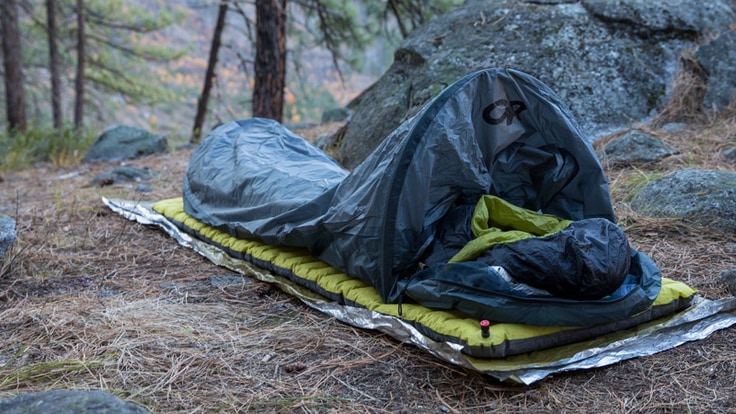Who uses bivy sacks? People who:
- Frequently travel solo in the backcountry.
- Climb big-wall routes that require more than a day to complete.
- Camp during long-distance biking trips.
- Seriously desire to shed every possible ounce from their loads.
- Go winter camping in snow caves.
This article covers the basics of bivy-sack selection.
Video: How to Choose Bivy Sacks
Bivy Basics
Bivy sack is short for "bivouac sack." It was invented to serve climbers who wanted lightweight emergency weather protection for sleeping bags during multiple-day ascents, particularly on big walls.
Early bivy sacks were little more than waterproofed nylon slipcovers for sleeping bags—good for shielding sleeping bags from rain, not so good when ventilating vapor produced by body heat.
Bivy design today involves 2 tiers of fabric:
- The bottom tier typically consists of a durable grade of nylon coated with urethane to make it waterproof. This is the same material used for most tent floors.
- The top tier is usually made of ripstop nylon (a lighter fabric) and treated with a waterproof, breathable laminate such as Gore-Tex®.
For an extra pound or so, a tent-like bivy shelter adds 2 features not available with traditional bivies—an expanded area of shielded headspace and a full enclosure to block out bad weather and insects. These extras have helped bivy shelters grow in popularity, particularly with ultralight hikers.
Bivy Sacks vs. Shelters
A traditional bivy sack is intended primarily for mountaineers or committed minimalists. It performs 2 basic functions:
- It keeps a camper's sleeping bag dry.
- It increases its warming capacity by about 10°F.
A bivy sack's head opening means moisture can potentially find its way inside. You can minimize that risk by pulling the headhole's drawstring very snugly. This tends to turn the headhole into more of a nosehole, which some people find far too restrictive. Many minimalists, though, are willing to make this sacrifice.
Features worth considering:
- Multiple zipper sliders allow you to create armholes so you can sort gear or cook while being protected by the bivy.
- Full-length zippers provide multiple ventilation options.
- Factory-sealed seams for waterproofness.
- Straps that let you secure your sleeping pad in place.
Bivy shelters are low-rise tents that include mesh panels attached to the head opening, plus poles or hoops that lift fabric off your face. They allow you to shut out bugs and rain, though downpours may require careful venting to stay dry.
Shelters are best for ultralight backpackers and touring cyclists. Their fortified wedge of head space provides just enough of a comfort zone to make a bivy's restricted air space feel acceptable. In rainy areas, bivy shelters lose some of their appeal; it can be tough to wait out a storm inside a shelter that offers no sit-up space.
Bivy Considerations
Is a bivy too tight for you? Both sacks and shelters require a Spartan mindset. But don't dismiss this style of shelter too quickly. While a tent offers a roomier, roof-over-your-head sensation, a bivy is almost like sleeping under the stars—a very liberating experience. At the same time, you are protected from bugs and rain by a very lightweight barrier. However, if tight spaces make you uneasy, you are likely to feel uncomfortable inside a bivy. In that case, move up to a tent.
How does air circulate inside a bivy? Breathable/waterproof laminates such as Gore-Tex® fabric make it possible for vapor produced by body heat to be pushed through (and out of) the fabric. This works best when a warm, humid body is resting somewhere cool and dry. In rainy conditions, you should have enough overlapping material and zippers so it is unlikely you will have to completely zip them shut. Manually venting a zipper or flap helps maintain an acceptable interior humidity level.
Can condensation be a factor with a bivy? Potentially, yes. A bivy is basically a single-wall tent. When vapor escapes from your body or lungs, it rises to meet colder air. At some point, the air can no longer carry all this moisture, so some may collect on the inner wall of the treated bivy fabric. In 2-walled tents, by contrast, this moisture passes through the canopy and settles on the rainfly.
Will a bivy really keep a sleeping bag dry? When wet, Gore-Tex fabric sometimes produces a clammy feeling when it touches your skin, but it's just that—a sensation, not a soak-through. Good ventilation helps minimize this condition.
How minimalist can I go? In warm conditions, some people skip a sleeping bag altogether and simply sleep inside the bivy shell.
